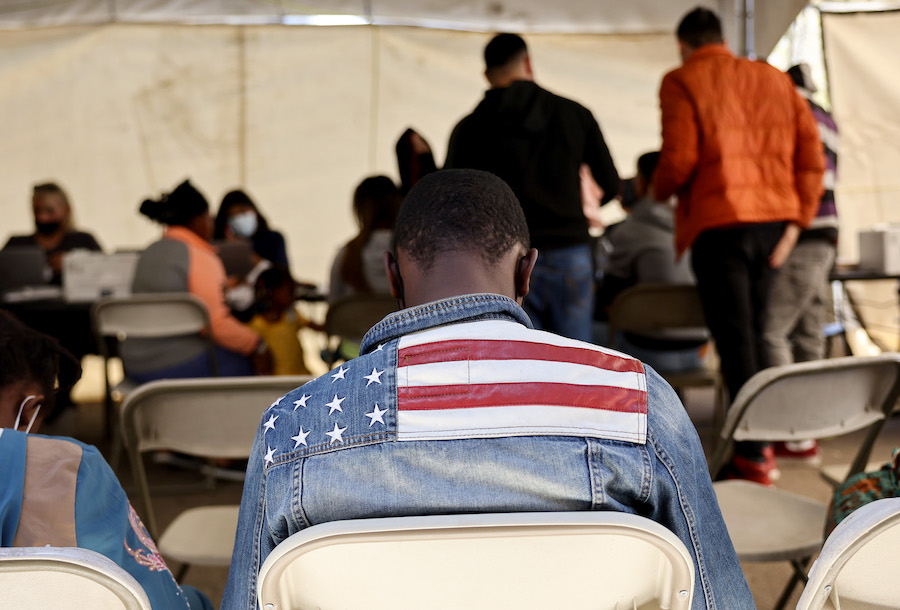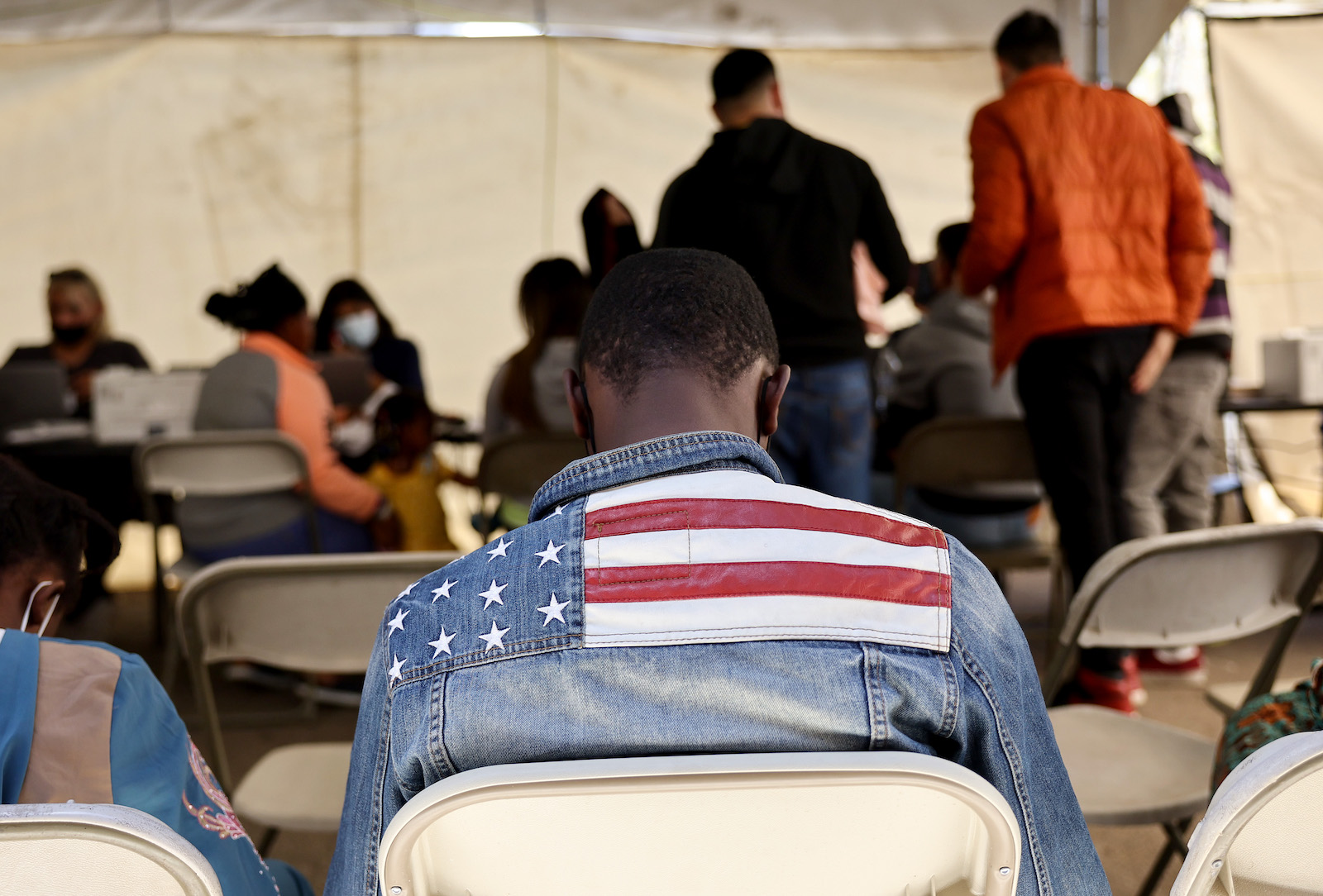On May 11 Title 42 finally expired. The public health order, issued by the Trump administration in March 2020, almost completely shut down asylum processing at our southern border; in the last three years the US has conducted approximately 2.8 million expulsions of migrants, regardless of their reasons for trying to enter the country. The Department of Homeland Security (DHS) should have promptly returned to processing migrants under our existing immigration laws, which allow people who enter without authorization to seek asylum if they successfully demonstrate a credible fear of persecution or torture. Instead, the same day, President Biden implemented his own ban on asylum seekers at the US–Mexico border.
Under this new policy, which bears a striking resemblance to a similar asylum ban issued by President Trump in 2019, nearly all migrants who fail to seek asylum in another country first or secure an appointment to enter at a land port of entry will be presumed ineligible for asylum when they reach US territory. This blocks most would-be asylum seekers at the southern border from making asylum claims, with the justification that they should have availed themselves of another immigration pathway before traversing Mexico—an option currently only available to immigrants from a handful of countries. The rule effectively normalizes the dangerous theory that, because certain migrants are at once less deserving of humanitarian protection than others and more threatening to the social cohesion of our democracy, the US can dispense with its legal obligations under the Refugee Act of 1980 to individually review every asylum case.
Asylum is just one legal pathway for foreign nationals to enter the United States—others include family and employment–based visa systems, temporary work visas, and tourist visas—but it is the last resort for people with few resources and limited legal options. Of the millions of immigrants who live in the United States, these are the people on whom our national debate has come to center: the migrants at the southern border who file asylum claims.
Those claims are hard to prove. Since the option was first legally codified in 1980, the majority of people who have applied for asylum as a defense against their deportation have been denied. An asylum seeker must meet the legal definition of a refugee: someone who has experienced persecution or has “a well-founded fear of persecution on account of race, religion, nationality, membership in a particular social group, or political opinion.” They have the burden of showing they meet this standard by collecting their own evidence and preparing arguments that must be informed by decades of case law. Those who prevail in their claims can eventually become US citizens. But most asylum seekers at the border are likely migrating for reasons not covered by asylum law, even if they are fleeing their countries for pressing humanitarian reasons, such as the outbreak of war. Predominantly Black, brown, and indigenous, they leave their countries of origin due to a wide range of economic, political, and environmental factors; many of them cross several countries with the hope of finding refuge at the US–Mexico border.
Their growing presence has tested lawmakers in both parties. Republicans, who have the most to gain from any perceived chaos in the immigration system, have made asylum a straw man in the service of a goal informed by white nationalist ideology: restricting immigration to the United States as much as possible to foreign nationals from majority white countries. For proponents of the Great Replacement Theory, these restrictions are ultimately a way to close the border and prevent nonwhite people from replacing the white population. To that end, the most extreme wing of the Republican Party has cast asylum seekers as a grave threat to border security and refused to engage with popular immigration reforms, like providing a path to citizenship for Dreamers, without ending asylum in exchange. For years they have been pressuring Democrats to weaken their commitment to asylum and revert the United States’s immigration system to a time when we had no legal obligation to provide humanitarian protections to refugees at our borders. Democrats, for their part, have promised to reform the entire immigration system to better meet the nation’s social, economic, and political needs. But they have grown tired of migration at the border because their Republican opponents use it to narrow their political room to maneuver on their other legislative priorities.
I witnessed this shift in the spring of 2014, as an immigration policy staffer at DHS. The images of thousands of unaccompanied children and families at the border, huddled under mylar blankets in concrete holding cells, provoked a political crisis for the Obama administration. These families did not fit the profile of late Cold War–era asylum seekers: single adults fleeing communism or anti-Christian persecution. Instead they were fleeing horrific gang violence and other life-threatening conditions, mostly in Central America. Republicans claimed, without evidence, that Obama’s creation of the Deferred Action for Childhood Arrivals program in 2012 was to blame for the crisis.
As that crisis unfolded, I saw that leaders in the administration were reluctant to recognize the families as asylum seekers. They asked whether our laws provided too many protections for unaccompanied children and whether it had become too easy to seek asylum. Starting in 2014, they experimented with detaining families—who had never in recent memory been detained in large numbers—during their immigration proceedings, hoping to discourage others from following. Not all migrants at the border would qualify for asylum, but our laws required that each family be given the opportunity to try.
The Obama administration had a limited ability to organize a robust humanitarian reception for those families, even if it had wanted to. Our border infrastructure has never been equipped to safely process and temporarily detain large numbers of migrants. Processing requires an immigration official to screen people for asylum claims, conduct background checks, issue court documents, prepare people for deportations, and coordinate whether a person is transferred to a detention center or released into the community. All this takes place at a border patrol station, a port of entry, or in large tents temporarily set up along the border. When processing facilities reach capacity, DHS often releases people into the streets of border communities in the US, prompting a predictable storm of media attention and fearmongering that the border is not secure. Fixing the operational inefficiencies at our borders remains an immense challenge. But any real solution will require recommitting to the principles that inspired the creation of our asylum system in the first place.
The US immigration system was once designed to maintain explicit hierarchies of race, religion, and ethnicity. This was the logic behind the Chinese Exclusion Act of 1882, racial quotas for Eastern Europeans in the 1920s, and the fifty-two Supreme Court decisions in the early twentieth century that limited US citizenship to immigrants deemed sufficiently white. Before World War II the US lacked any statutory mechanism to admit people fleeing persecution, leading it to reject Jewish refugees during the Holocaust. It was to remedy this problem that Congress passed the Immigration and Nationality Act of 1965 and the Refugee Act of 1980. These bipartisan reforms embodied the principle that any immigrant, regardless of background, could become an American if they followed our laws.
Our asylum process did not exist in statute until the passage of the second of these laws. The Refugee Act provided that any individual could seek asylum as long as they were on US territory and could establish that they were persecuted for being a member of a protected group. Before Trump invoked Title 42, a migrant at the US–Mexico border would be screened by a border agent who would determine whether the migrant was claiming a fear of persecution or seeking a nonlegal basis for admission into the United States—if, for instance, they were migrating for economic reasons. Once an asylum seeker established a credible fear of persecution, they were typically released from DHS custody or transferred to a detention facility until an immigration judge could decide their asylum claim.
When Donald Trump’s campaign launched in 2015, the dehumanization of migrants at the border was central to his project of restoring a racialized hierarchy to our immigration laws. President Trump was explicit in his hatred of asylum seekers, and his policy approach was blunt and cruel. He intentionally separated children from their families, forced over 60,000 asylum seekers to wait in Mexico, and placed children under the age of five alone in detention facilities. Then, over the protests of public health experts at the CDC, he used the pandemic as a pretext to issue a public health order invoking a 1944 statute from Title 42 of the US Code that provided for the “suspension of entries and imports from designated places to prevent spread of communicable diseases.” With the Title 42 order in place, border agents did not have to screen people for asylum at all; they could turn migrants back to Mexico or expel them to their country of origin within a few hours or days.
The public opposition to Trump’s immigration policies made it politically convenient for Joe Biden to campaign on the promise that he would restore access to asylum and for Jill Biden to visit asylum seekers living in a dangerous encampment in Matamoros, Mexico. In 2020 it was easy to call Trump’s policies racist because he was so vocal in his belief that asylum seekers threaten the racial makeup of the country. But when it came time to undo those policies, the Biden administration chose to preserve the most restrictive one.
When I joined the administration on January 20, 2021, it quickly became clear that most of my new colleagues could not conceive of a future without Title 42. Even though the order was, in effect, driving more irregular migration to the border by allowing people to attempt entry multiple times, it allowed administration officials to put off the daunting tasks necessary to begin processing asylum seekers again, including reducing the immigration court backlog, modernizing Border Patrol facilities, building new Ellis Island–style processing centers, conducting regular deportation flights, and coordinating the arrival and integration of thousands of asylum seekers at the border. In the midst of the pandemic, these tasks would have come with the additional operational burdens of Covid-19 safety protocols, testing, and vaccination.
Title 42 also eliminated a still more difficult stressor for the new administration: the need to manage the political backlash that has been provoked almost every year since 2014, whenever images of Black, brown, and indigenous migrants arriving in border cities become national news stories. Year after year, Republicans argue that these migrants are trying to circumvent our laws while Democrats struggle to say why they deserve humanitarian protections. The conditions that migrants are fleeing rarely figure prominently in this debate.
To navigate these politics, the Biden administration crafted different responses for different groups of migrants. Under Title 42, DHS had the discretion to exempt some people from expulsions or provide additional screenings to ensure that migrants were not being sent back to gravely dangerous situations. Two major border challenges, happening months apart, revealed that the Biden administration was comfortable applying those provisions selectively.
In September 2021 an estimated 15,000 mostly Haitians reached the border at Del Rio, Texas, a remote area with only one migrant shelter. Many of these migrants had been living in Brazil and Chile since the 2010 earthquake, but lost work or temporary legal status when the economy constricted. Haitians had few legal options to find refuge anywhere but the United States. They faced extreme anti-Black racism in most of Latin America, and once they arrived in Mexico, racism there too made it difficult for them to find work or housing. Title 42 gave Biden the option to simply expel a majority of them back to Haiti, where they would face extreme political turmoil and violence, without screening them for potential asylum claims or temporary protections like humanitarian parole. The administration also knew that some of these Haitians had children who were citizens of Brazil and Chile, and we would be deporting them to a country where they had few social or familial ties.
The exemptions provided for in the Title 42 order gave DHS an alternative to mass expulsion, but the administration did not take it. Instead it raced to complete the operation. When a photograph circulated of a father crossing the border carrying food for his family and a Border Patrol officer on horseback trying to push him back to Mexico with a rein, it provoked a national uproar. Civil rights leaders protested Title 42 as an undeniably anti-Black policy, and even Senate Majority Leader Chuck Schumer called it xenophobic. The backlash became so intense that I wondered whether White House officials would reconsider. But they stayed the course. Two high-profile officials protested the expulsion operation, publicly criticizing the administration for continuing to rely on Title 42.
I resigned from the administration in October 2021. Four months later the other choice became clear. When Russia invaded Ukraine, thousands of Ukrainians fled Europe for Mexico seeking entry into the United States. This time the Biden administration accommodated them. Not only did it allow approximately 20,000 Ukrainians in Mexico to enter the US, it also created Uniting for Ukraine, a first-of-its-kind parole program for Ukrainians to fly here directly from another country—making it easier for them to receive parole than the tens of thousands of Afghans who are still waiting to relocate to the United States.
The border operation and the new program were widely praised by both parties. Republicans neither challenged the use of the parole authority nor called the gathering of Ukrainians at the border any kind of crisis. DHS conducted one of the most impressive border operations that I have ever seen. When our government wants to solve challenging operational issues, it does. The difference between Ukrainians and Haitians was not a legal one. In both cases many of the migrants would not have been eligible for asylum, since fleeing war and generalized violence are in themselves insufficient to meet the high legal bar for an asylum claim. The primary difference was race.
As the spread of the pandemic slowed in the following months, the Biden administration announced that it would rescind the Title 42 public health order. As immigration experts expected they would, Republican-led states sued to preserve the policy, giving Biden administration officials more time to deny asylum to additional nationalities. First they announced that they would begin to expel Venezuelans at the border—most of whom had until then been permitted to pursue asylum claims—and allow some of them to apply for a two-year humanitarian parole program with strict application requirements that excluded Venezuelans who had already fled to Panama or Mexico.
Then, in January, the Biden administration began applying a similar policy to Cubans, Nicaraguans, and Haitians, crafting a deal that allowed it to expel 30,000 people a month to Mexico and approve the same number of parole applications a month for migrants who could apply while still in their home countries. The program’s requirements are more restrictive than those for Ukrainians. A Ukrainian applicant who applied for parole from a third country, for example, would still be eligible, whereas an applicant from Haiti who fled to Mexico rather than waiting in Haiti to apply would no longer meet the program’s criteria. By imposing these requirements the government was, in effect, testing out ways to penalize only certain migrants for choosing to seek asylum in the US over other countries along their migratory route. While these parole programs opened up legal pathways to potentially 360,000 new immigrants a year, they also served to deflect critiques of the new asylum ban the administration announced that same month.
According to the new rule, most non-Mexican migrants who do not seek asylum in a third country first are presumed ineligible for asylum in the US. The Trump policy this ban resembles was enjoined in court in 2019 for being inconsistent with existing asylum laws. But the ban generated weak opposition from Democrats in Congress and liberal pundits, who were quick to defend it as a necessarily tough measure to appease Republicans opposed to Biden’s border policies.
For migrants who do make it to the southern border without seeking asylum in another country first, the rule includes a second option: they can present themselves at a land port of entry “at a prescheduled time.” This stipulation might seem reasonable if it was easy for migrants to present their claims to immigration officers at ports of entry, but these ports, with multiple vehicle lanes and limited space for pedestrians, are designed to facilitate trade, travel, and tourism, not accommodate the needs of migrants. The Biden administration has tried to make things easier by expanding the use of a smartphone app, CBP One, that allows people to make appointments to enter; anyone who fails to make an appointment through the app, however, will, with limited exceptions, be presumed ineligible for seeking asylum and deported. For most migrants, access to a smartphone is now essential to access asylum. Slots are limited to a thousand people a day, allocated across the entire border, so most people will still be forced to wait for their opportunity in the same dangerous encampments on the Mexican side of the border that the administration once attempted to eliminate.
Congress was explicit in 1980 that a migrant could make an asylum claim no matter where they entered the US. President Biden’s direct contradiction of that law is extreme, a shift so far to the right in our conception of how the US should treat asylum seekers that it undermines the ambitious principles that supported the passage of the Refugee Act and threatens any near-term prospect of Congressional action on immigration reform. What started as a temporary public health restriction created by an explicitly xenophobic administration has evolved into a two-year asylum restriction maintained by a Democratic president. Republicans no longer have to compromise on broader reforms, such as establishing a path to citizenship for the eleven million undocumented people living in the United States, because the Biden administration is restricting asylum without demanding any policy concessions in return.
In my time in government, many of my colleagues argued that I was wrong to view immigration as a racial justice issue. But the history of global antidemocratic politics shows us that nationalist movements rely on immigration systems that minimize the number of nonwhite immigrants they welcome. For decades the Democratic party has promised voters, especially voters of color, that it can be a trustworthy steward of marginalized communities. Since the launch of his campaign Biden has said that he views the growth of white nationalist forces as the greatest threat to our country. But to deliver on his party’s promise, his administration must recognize that the immigration debate is over nothing less than the ability of the United States to exist as a multiracial democracy—one that refuses to limit access to citizenship on the basis of race, religion, or nationality.
We have seen in the past three years how easily racial preferences can be used to decide who we allow to seek refuge—even if it means designing new legal pathways for them—and who we turn away. We need to ensure that immigration policy is never used to dehumanize specific groups of human beings or signal that some nationalities are a threat to the American way of life. In an equitable system, this would mean not only allowing migrants to make the asylum claims to which our laws entitle them but also looking beyond asylum as the only option for today’s most vulnerable migrants. The US should be leading the way in creating new legal pathways to citizenship or temporary residency for these people fleeing climate change, economic collapse, gender-based violence, and other dangers not currently protected.
Since September 11, Democrats have tried to make Republicans negotiate on immigration reform by offering billions of dollars to secure the border and, now, restricting asylum. Instead we ought to be explaining to voters that a future immigration system should complement asylum with a new set of flexible, accessible legal pathways that give people the option to stay and work in the US, even temporarily, rather than being sent back home to unlivable conditions. There are signs of hope that such a strategy could be popular. Over a million Americans have signed up to sponsor Cubans, Haitians, Nicaraguans, and Venezuelans for Biden’s parole program, rejecting the Republicans’ racialized argument that the US cannot manage more immigration. Republicans are already challenging these parole pathways in court. Congress should move quickly to codify them. Doing so will show other democracies that we view migration not as a threat but as a way to move closer toward fulfilling the promise of a multiracial democracy.
When Congress reformed our immigration laws in the decades after the Holocaust, a bipartisan group of lawmakers made an explicit attempt to reject our country’s history of using the immigration system to preserve white supremacy. Now immigration policy is starting to resemble our old regime, when politics justified turning away boats of Jewish refugees, sending some of them to face certain death. We should not let asylum die just because it has become more difficult to provide.



